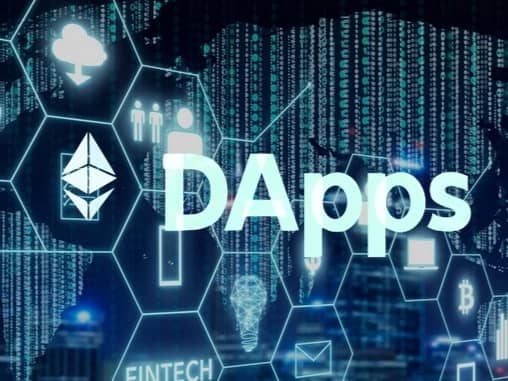订阅 wiki
Share wiki
Bookmark
Decentralized Application (dApp)
Decentralized Application (dApp)
去中心化应用程序(dApp、Dapp 或 DApp) 被设计为在 区块链 网络之上运行的 开源 项目。这些网络的分布式特性为用户提供了透明性、去中心化 和抵御攻击的能力。
去中心化应用程序通过代币化系统(通过使用 智能合约 创建的数字代币)来推动其自身的活动。代币可以是特定于特定 DApp 的(Steemit 上使用的 Steem 代币),也可以是 DApp 托管的区块链的原生代币,例如 CryptoKitties 使用 以太币 (ETH)[1]。
已创建的各种 DApp 包括游戏、社交媒体平台、加密货币钱包和金融应用程序 DeFi(去中心化金融)[2]。
概述
自 P2P 网络出现以来,去中心化应用程序就已存在。它们是一种软件程序,旨在以不受任何单一实体控制的方式存在于互联网上。
去中心化应用程序不一定需要在 区块链 网络之上运行。BitTorrent、Popcorn Time、Bitmessage 和 Tor 都是传统的 DApp,它们在 P2P 网络上运行,但不在区块链上(区块链是一种特殊的 P2P 网络)。特别是,区块链最常用于创建奖励和激励系统,方法是将应用程序与 加密货币 的代币或单位相关联,这些代币或单位是为应用程序贡献价值而提供的[6]。
与 比特币 意义上的简单智能合约(将资金从 A 发送到 B)相反,DApp 在市场的各个方面都有无限数量的参与者[4]。
DApp和智能合约的区别
DApp是支持区块链的应用程序,智能合约使其能够连接到区块链。理解这一点最简单的方法是了解传统网站的运作方式。
传统的Web应用程序使用HTML、CSS和Javascript来呈现页面。它还需要利用API从数据库中获取详细信息。当您访问Facebook时,页面将调用API来获取您的个人数据并在页面上显示它们。
- 传统网站:前端 → API → 数据库
去中心化应用程序与传统的Web应用程序类似。前端使用完全相同的技术来呈现页面。一个关键的区别是,您拥有一个连接到区块链的智能合约,而不是API连接到数据库。
- 支持DApp的网站:前端 → 智能合约 → 区块链
与传统的中心化应用程序(后端代码在中心化服务器上运行)相反,DApp的后端代码在去中心化的P2P网络上运行。
去中心化应用程序由整个包组成,从后端到前端。智能合约只是DApp的一部分:前端(您可以看到的内容)和后端(后台逻辑)。
另一方面,智能合约仅包含后端,通常只是整个dApp的一小部分。这意味着,如果您想在智能合约系统上创建一个去中心化应用程序,则必须组合多个智能合约,并依赖第三方系统来实现前端。
DApp可以具有用任何语言(就像应用程序一样)编写的前端代码和用户界面,这些语言可以调用其后端。此外,其前端可以托管在去中心化存储(如Swarm或IPFS)上。
区块链 DApps
要使一个应用程序被认为是区块链环境下的 DApp,它必须满足以下标准:
- 该应用程序必须是完全开源的。它必须自主运行,并且没有任何实体控制其大部分代币。
- 该应用程序可以根据提出的改进和市场反馈来调整其协议,但所有更改必须由其用户的共识决定。
- 应用程序的数据和操作记录必须以加密方式存储在公共的、去中心化的区块链中,以避免任何中心故障点。
- 该应用程序必须使用加密代币(比特币或其系统原生的代币),该代币对于访问该应用程序是必要的,并且来自(矿工/农民)的任何价值贡献都应该以该应用程序的代币奖励。
- 该应用程序必须根据标准的加密算法生成代币,作为价值证明,节点正在为该应用程序做出贡献(比特币使用工作量证明算法)。
DApp的开发过程:白皮书与原型
发布白皮书,描述DApp及其功能。该白皮书可以概述DApp开发的思路,也可以包含一个可行的原型。
可能会有代币销售:设立初始代币销售,也称为首次代币发行(ICO),通过这种方式来分散DApp的所有权。启动资金用于构建和部署DApp。[5]
DApp 许可证
在开放源代码许可下运行,DApp 可以开放创新,不受版权或专利的限制。此外,通过完全开源,去中心化应用程序可以在开源软件的法律模型下运行。例如,比特币使用 MIT 开源软件许可证。
适用于 Dapp 的平台
EOS、以太坊、TRON、IOST、Steem (区块链) 和其他类似的区块链旨在为构建去中心化应用程序创建协议。这些是您现在可以用来将功能齐全的应用程序部署到相对广泛的社区,并提供相对可用的开发者工具的平台。
这些区块链为开发者提供了一个基础层:一个内置图灵完备编程语言的区块链,允许任何人编写智能合约和去中心化应用程序,在其中可以为所有权、交易格式和状态转换函数创建自己的任意规则。
Dapp 可以在 State of the DApps、Dapp.com、Holdex、DAppRadar 和 CoinGecko 等市场上浏览。
流行的 DApps
- Uniswap
- MindSwap
- Augur
- PredIQt
- Polymarket
- MetaMask
- Sense Chat[3]
- Pancakeswap
- Axie Infinity
- Opensea
- Rarible
- Sandbox
- Aave
dApps 和 web3 应用程序
Web3 是加密领域的万维网,web3 应用程序是使用区块链技术构建的任何应用程序。您可以使用加密钱包连接到 web3 应用程序。有许多不同类型的 web3 应用程序,从游戏到 DeFi 再到 NFT 平台。
dApp 是一种特定类型的 web3 应用程序。所有 dApp 都是 web3 应用程序,但并非所有 web3 应用程序都是 dApp,因为并非所有 web3 应用程序都是去中心化的。但是,这两个术语可以互换使用。所有 dApp 和 web3 应用程序都与加密钱包连接。
要使 web3 应用程序被视为 dApp,更改应用程序的权力必须分配给多个参与方。许多 dApp 使用 DAO 以去中心化的方式管理应用程序。[7]
AI与dApp的融合
人工智能(AI)和Web3技术的融合正在为去中心化应用(dApps)的新时代铺平道路,这些应用更加智能、更具互动性且高度安全。
人工智能处理大量数据并从交互中学习的能力使其成为Web3中的宝贵资产。从AI驱动的智能合约,基于数据驱动的决策自主执行任务,到通过个性化体验增强用户交互,AI正在改变dApps的运作方式。
AI赋能的dApps在Web3领域变得越来越普遍。这些应用程序利用AI提供创新的解决方案,例如自动化财务建议、预测市场走势等。人工智能的集成不仅增强了这些dApps的功能,还提高了用户参与度和信任度。
开发AI Web3 dApps面临着一系列挑战,包括由于处理大量数据而导致的可扩展性问题,以及AI和区块链技术之间复杂集成所产生的固有安全问题。
虽然AI可以通过自动检测和减轻潜在威胁来显着提高dApps的安全性,但它也引入了新的漏洞,尤其是在数据处理和隐私方面。
此外,在dApps中将AI与区块链集成需要仔细考虑互操作性和数据一致性。开发人员必须确保这两种技术无缝协作,以实现预期功能。[8]
带有大型语言模型 (LLM) 的 dApp
传统DApp的缺陷
传统的去中心化应用程序(DApps)在区块链等去中心化网络上运行,并通过智能合约执行。然而,这些应用程序在实际运行中暴露出一些显著的缺点。
首先,传统的DApp运营成本高,可扩展性有限。将数据存储在区块链上通常很昂贵,特别是对于数据密集型DApp,存储费用构成了相当大的运营成本。此外,每笔交易都需要gas费,随着时间的推移,gas费会不断累积,影响涉及频繁交易的DApp的经济可行性。
其次,传统的DApp对普通人来说不够友好。与中心化应用程序相比,使用DApp需要用户具备一定的Web3知识,增加了使用门槛。此外,DApp的用户界面通常比较简陋,降低了整体用户体验。
DApp 2.0
DAgent,由BytomDAO提出,代表了DApp 2.0,并利用大型语言模型(LLM)技术来解决传统去中心化应用程序(DApp)面临的挑战。虽然DApp通常在区块链网络上运行,并使用智能合约来自动化代码执行,但它们面临着可扩展性问题、高用户体验障碍、昂贵的数据存储成本和交易费用等限制。
D-Agent标志着下一代DApp,不仅仅是技术创新,更是设计理念和用户交互的飞跃。通过将大型语言模型(LLM)技术与区块链的优势相结合,D-Agent在技术实现和功能应用方面实现了多项关键突破:[9]
- 创新交互模型: 用户通过自然语言对话完成任务,降低了使用门槛,使非专业人士也能轻松参与,从而大大扩展了去中心化应用程序的受众。
- 成本优化: 模型执行在链下处理,将链上操作的高Gas费用转化为相对经济的GPU运行成本。同时,关键数据以向量形式存储在链上,确保数据的可验证性和可信度。
- 高效信息处理: 链下数据的实时集成和可定制插件增强了应用程序的信息处理能力,使D-Agent能够适应更广泛的应用场景和复杂需求。
- 智能应用扩展: Chain-of-Thought方法降低了开发难度,促进了各种智能应用的快速开发和部署,并促进了Web3生态系统的多样化。因此,得益于BytomDAO的愿景以及随附的服务和DAgent套件,基于AI的DApp在未来将变得越来越个性化,可能专门为个人用户提供服务。
发现错误了吗?
